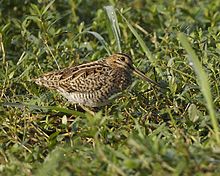Forest cassin
| Forest cassin | ||||||||||
|---|---|---|---|---|---|---|---|---|---|---|
| Systematics | ||||||||||
|
||||||||||
| Scientific name | ||||||||||
| Gallinago megala | ||||||||||
| Swinhoe , 1861 |

The forest cassin ( Gallinago megala ) is a medium-sized species from the family of snipe birds (Scolopacidae). Their breeding areas range from southern Siberia south to Mongolia ; There is another exclave in the far east of Russia on the Ussuri . The wintering areas extend from South and East Asia to northern Australia . The species is very similar to the Spießbekassine and can only be clearly distinguished from it in the field if the bird spreads its tail.
description
The forest snipe is a little larger than a snipe with a length of 27–29 cm , the beak is relatively slightly shorter with 54–72 mm. It is brownish or grayish green at the base and dark brown at the top. The wing length is 139–155 mm, the tail length 48–57 mm. The relatively long legs are greenish or greenish yellow. The iris is brown.
Like many species of the genus, the forest cassin shows a rough striped pattern on the head and back. The head pattern is made up of a beige crown, dark brown crown, beige over-eye stripe , dark eye stripe and reins as well as dark dotted lines that condense on the otherwise light-colored ear covers. The throat is whitish, the neck and chest are dashed brown, with the dashed lines merging into a coarser pattern of banded feathers on the sides of the chest and flanks. The banding continues on the under tail-coverts. The back of the chest and lower abdomen are white. The shoulder and back feathers are blackish brown in the centers with rust-brown markings. Yellowish beige hems form a striped pattern on the top. The upper side of the wing is predominantly dark brown to blackish with yellowish beige lined and partly banded arm covers, a narrow, light wing band, which is formed by the tip hems of the large arm and inner hand covers and a barely visible, light rear edge. The under wing-coverts are almost completely banded on a whitish background and relatively finely dark brown.
The main defining feature of the species and the only sure differentiation from the spit kassine is the tail, which usually consists of ten, less often nine or up to thirteen control feathers. While the outer, rather narrow control feathers on a dark gray-brown background are lightly pointed and broadly banded, the pattern on the inner pairs is divided into a very dark brown base, a broad rust-brown band on the distal quarter, a dark brown subterminal band and a yellowish-beige to whitish end hem. In contrast to the Spießbekassine, the outer control feathers are 20 mm from the tip, 2–4 mm wide and not very narrow.
The forest cassin stands in size between two very similar species, the larger Japanese cassin ( Gallinago hardwickii ) and the smaller spit cassin. They differ from the common snipe ( Gallinago gallinago ) by the area-wide banded under wing-coverts, the possibly very narrow, light-colored trailing edge of the wing and the rein stripe, which is narrower at the base of the beak than the rather wide over-eye stripe there. The Japanese cassin differs from the other two Asiatic species in size and proportions, clearly elongated umbrella feathers and a longer tail.
Way of life
The forest snipe inhabits semi-open landscapes in river valleys, where it breeds in somewhat drier places than the sympatric snipe. The breeding season is between May and August. The males' courtship flights can be observed especially at dusk. With these it circles singing at a great height and can then slide down, whereby the splayed outer control springs generate a deep and drawn-out neighing noise made up of two alternating tones of different heights.
hikes
The forest cassin is a migratory bird that winters in the tropical regions of South and Southeast Asia and Australasia . The winter distribution extends from southern and eastern India , southern China and Taiwan via the Philippines , western Micronesia and New Guinea to northern Australia. They overlap widely with those of the Spießbekassine. The forest cassin is a much more frequent winter visitor east of the Philippines than the latter. The arrival in the Australian winter quarters is around November, the return home is mostly by mid-April.
literature
- Peter Hayman , John Marchant, Tony Prater: Shorebirds: An identification guide. , Houghton Mifflin Company , Boston 1986, ISBN 0-395-37903-2 .
Individual evidence
- ↑ Swinhoe's Snipe at orientalbirdimages.org, see Taxonomic Notes there
- ↑ Hayman et al. (1986), pp. 170f and 349f, see literature
Web links
- Gallinago megala in the endangered Red List species the IUCN 2012. Posted by: BirdLife International, 2009. Accessed October 17, 2012th
- Photos Gallinago megala in the image database of the Oriental Bird Club , accessed on 17 October 2012
- Videos, photos and sound recordings for Gallinago megala in the Internet Bird Collection